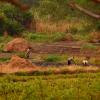News

26 July 2024
Navigating new horizons to protect human and planetary health
As environmental, technological, and societal change join forces to disrupt human and planetary health, the world must get better at tracking and responding to a host of emerging challenges, according to a new report from the United Nations Environment Programme (UNEP) and the International Science Council (ISC).

22 July 2024
Vietnam Academy of Science and Technology (VAST) visits IIASA
On 22 July, 2024, a high-level delegation from the Vietnam Academy of Science and Technology (VAST), led by Professor Tran Tuan Anh, visited IIASA to meet with Director General John Schellnhuber and IIASA researchers to discuss ongoing research projects and opportunities.

14 June 2024
IIASA Leadership visits Washington DC
In May, IIASA Director General John Schellnhuber and Head of Communications and External Relations Barbara Kreissler traveled to Washington DC for a series of meetings with members of the US IIASA Committee and other key stakeholders. The trip aimed to strengthen relationships and explore new opportunities for collaboration.
Focus

29 August 2024
Experiencing the science that we write about
IIASA researcher, Linda See, shares her experiences at the coalface of where plastic pollution is collected by volunteers during a beach cleanup event.

08 July 2024
Future food demand in The Gambia: can increased crop productivity and climate adaptation close the supply–demand gap?
The Gambia faces significant food availability issues due to low agricultural productivity. IIASA researchers and colleagues used the FABLE Calculator to explore actions to reduce the food supply-demand gap by 2050. The results, published in Food Security, reveal that current cropland will not meet food demand by 2050.